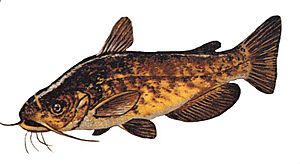Ameiurus facts for kids
Quick facts for kids Ameiurus |
|
|---|---|
 |
|
| Ameiurus nebulosus | |
| Scientific classification |
|
| Kingdom: | Animalia |
| Phylum: | Chordata |
| Class: | Actinopterygii |
| Order: | Siluriformes |
| Family: | Ictaluridae |
| Genus: | Ameiurus Rafinesque, 1820 |
| Type species | |
| Silurus lividus Rafinesque 1820
|
|
| Synonyms | |
Ameiurus is a group of catfishes that belong to the family Ictaluridae. This group includes the three most common types of bullhead catfish found in the United States. These are the black bullhead (Ameiurus melas), the brown bullhead (Ameiurus nebulosus), and the yellow bullhead (Ameiurus natalis). Other fish, like the white catfish (Ameiurus catus), are also part of this group but are not usually called "bullheads."
You can tell bullheads apart from other catfish like channel catfish and blue catfish by their tailfins. Bullheads have tails that look squared, while the others have tails that are forked, like a "V" shape.
Contents
Understanding Bullhead Catfish History
Scientists believe that all Ameiurus species come from a single ancestor. This means they form a natural group. They are closely related to other catfish groups like Noturus, Prietella, Satan, and Pylodictis. The black bullhead (A. melas) and the brown bullhead (A. nebulosus) are like "sister species" because they are very closely related.
Types of Bullhead Catfish
There are different kinds of bullhead catfish. Some are still alive today, and some are only found as fossils.
Living Bullhead Species
Currently, there are seven types of Ameiurus catfish that are still alive:
- Ameiurus brunneus (Snail bullhead)
- Ameiurus catus (White bullhead)
- Ameiurus melas (Black bullhead)
- Ameiurus natalis (Yellow bullhead)
- Ameiurus nebulosus (Brown bullhead)
- Ameiurus platycephalus (Flat bullhead)
- Ameiurus serracanthus (Spotted bullhead)
Extinct Bullhead Species
Scientists have found eight types of Ameiurus catfish that are now extinct. The oldest one, A. pectinatus, shows that this group of fish has been around for about 30 million years. This was during a time called the Oligocene epoch.
- †Ameiurus hazenensis
- †Ameiurus lavetti
- †Ameiurus leidyi
- †Ameiurus macgrewi
- †Ameiurus pectinatus
- †Ameiurus reticulatus
- †Ameiurus sawrockensis
- †Ameiurus vespertinus
Where Bullhead Catfish Live
Living Ameiurus catfish are naturally found in eastern North America. Their home range stretches from central Montana down to Texas. They live in streams that flow into the Gulf of Mexico and the Atlantic Ocean. You can also find them north into parts of Canada, like New Brunswick, Quebec, Ontario, Manitoba, and Saskatchewan.
Bullhead Habitat and Diet
Bullheads can live in many different places. This includes ponds, rivers, and lakes, even if the water is a bit salty or has low oxygen. They are bottom feeders, meaning they look for food near the bottom. They will eat almost anything that is edible. This includes dead fish, insects, other small fish, grains, fruits, and even crayfish.
People usually don't try to catch bullheads specifically for sport. They are often caught by accident when people are fishing for other types of fish. If you want to catch bullheads, you can use the same baits as for channel catfish. Good baits include cut-up fish, chicken livers, or other strong-smelling foods. Bullheads have an amazing sense of smell, even better than most dogs!
How to Identify Bullhead Catfish
Bullheads don't grow as big as some other North American catfish. Most bullheads weigh between one and two pounds. The biggest bullhead ever caught was less than 10 pounds.
It can be tricky for new anglers to tell bullheads apart from other catfish. For example, small flathead catfish also have squared tails and can look brown and spotted, similar to brown bullheads. However, there are key differences. A flathead's lower lip sticks out more than its upper lip, and its head looks flat, like a shovel.
Flatheads and bullheads also have different habits and prefer different places to live. Flatheads usually only eat live things, while bullheads will happily eat dead fish or other small animals. You might find flatheads near the bottom of dams or in deep gravel pits. Bullheads, on the other hand, are more often found in murkier (cloudier) water. Also, flatheads can grow to be over 100 pounds, but the biggest bullhead ever recorded was an 8-pound black bullhead. The average adult bullhead is usually around 2 pounds, and brown and yellow bullheads are even smaller.
Bullheads and People
Many people consider bullheads to be "rough fish." They are not often caught for food, but they can be tasty if they are caught in clean water and cooked properly. In Minnesota, bullheads are important for commercial fishermen. They catch about 1 million pounds of bullheads each year. Bullheads can also be used as good live bait for bigger catfish, like flathead catfish, in places where it's allowed.
See also
 In Spanish: Ameiurus para niños
In Spanish: Ameiurus para niños

